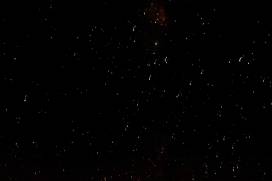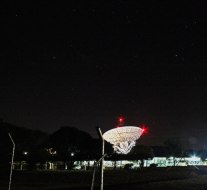
Main HartRAO dish
Radio telescopes study the universe using radio signals from the universe, but the same telescopes will also pick up radio signals made by humans here on Earth. Therefore, one of the big challenges for any radio astronomy project is finding a site for the telescope where the man-made signals don’t get in the way….
We recently made a trip out to the Hartebeesthoek Radio Astronomy Observatory (HartRAO) facility, west of Johannesburg to investigate the site for use in a new radio telescope project called HIRAX. We need a site that is quiet enough that man-made signals don’t overload our system (like they do in Durban, or most big cities).

Running the spectrum analyzer.
The way that you do this is to set up an antenna which is designed to work in the frequency band where you’re interested in working, and measure the frequency spectrum picked up by the antenna. To measure the worst of the man-made signals, you point the antenna at the horizon. Meanwhile, if you want to get an estimate of the actual signals your telescope will see, you point the telescope at the zenith.
So, over the course of an afternoon, we took many measurements in multiple sites around the facility to estimate the man-made signals (or RFI).
Because we wanted to monitor the site to see if the RFI varies as a function of time, we had to stay overnight and take late-night measurements as well. This gave me an opportunity to play with my camera to try and get some night shots.

Night Sky at HartRAO
One of the amazing things about living in the Southern Hemisphere is the fact that the night sky is new to me and brighter than I’m used to. This is because the center (brightest part) of the Milky Way galaxy is only visible in the south. I tried to get a shot of the amazing view, which only kind of worked, the streaks of light are single stars which show up as streaks due to the long exposure time.
It was interesting to see the shift in climate from Durban, even though it’s a short flight/few hour drive away. Inevitably, the monkeys were still around and we did get a few glimpses of other exotic animals like ostriches and giraffes. However, the most noticeable thing was the fact that the hills were covered with brown grass rather than anything green.
So, it was fun to see another part of South Africa, and we got some good measurements that demonstrate the site’s feasibility for our project.


